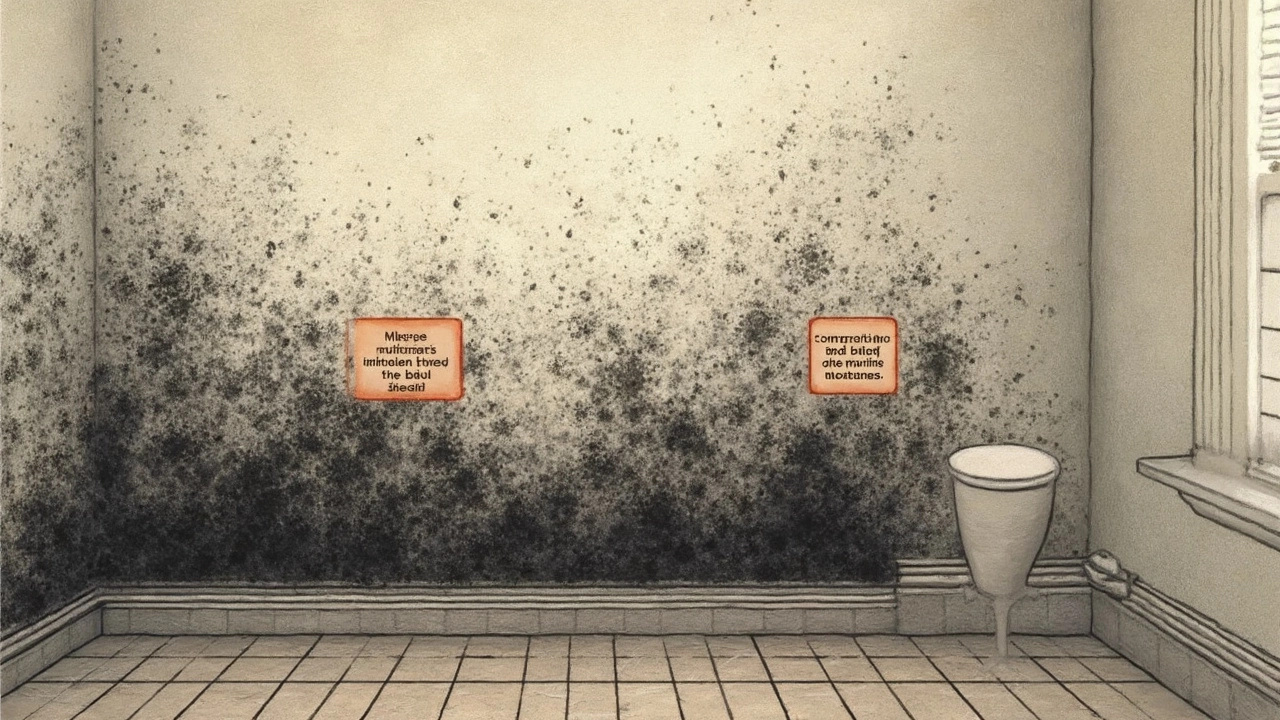Ever walked into a bathroom after someone’s shower and felt like you needed a scuba tank? That muggy, thick air clings to your skin and leaves towels perpetually damp. Or maybe your kitchen smells like fried onions for days, even if you cooked them last week. The real culprit? Skipping the extractor fan. You might think it's just about getting rid of smells, but the ripple effects go way beyond a whiff of last night's curry or steamy mirrors. Ignoring your extractor fan might seem harmless, but that tiny decision can create a storm of trouble inside your home—and even have a long-term impact on your health.
The Real Enemy: Moisture and Mold Build-Up
Let’s talk about moisture. Everyday activities like showering, boiling pasta, or just breathing add a surprising amount of water vapor to the air. If that water has nowhere to go, it clings to cold surfaces—bathroom tiles, mirrors, walls, even ceilings. That’s prime real estate for mold and mildew. And these guys aren’t just unsightly black dots or greenish fuzz; they’re little biological factories spewing spores into your air.
Research from University College London in 2021 showed that mold in damp homes was directly linked to an increase in asthma and allergy symptoms, especially in kids. The more humid and stagnant the air, the faster mold takes over. The Centers for Disease Control and Prevention (CDC) even lists poor ventilation as a key factor in residential mold outbreaks. It’s not just about musty smells; it’s about stuffy noses, itchy eyes, coughs that linger, and in some cases, more serious respiratory infections. Those constantly fogged-up mirrors and wet corners turn into mini laboratories for bacteria and mold.
Here’s a fun fact: A single hot shower can put as much as 1.5 liters of water into the air. That’s almost two full water bottles, swirling around and looking for a place to settle. Extractor fans yank that steam out right away, breaking the vicious cycle. If you skip them, the excess moisture will settle in hidden corners, inside wall cavities, or under floorboards. Eventually, wallpaper will start peeling, paint will bubble, and that lovely new bathroom or kitchen starts looking like a horror movie set. Mold can even eat through grout and drywall, causing expensive damage that’s tricky to fix.
If you live in a colder climate or have an old house with solid walls, you’ll notice condensation appearing more often. Every drop that sits unchecked is another opportunity for fungus to grow. Regular cleaning might help the surface, but if the humidity is always high, you’re just treating the symptoms, not the problem. The only easy and cost-effective solution is removing the moisture at the source with a fan. Otherwise, you’ll need to deal with the constant cycle of scrubbing, repainting, and in the worst cases, gutting big sections of your home.
Want to test your own home’s humidity? Pick up a cheap hygrometer: rooms should stay under 60% relative humidity. Anything above that and you’re basically handing out party invites to mold spores. Extractor fans make a huge difference, often dropping the humidity by 10–20% after a short run. That’s not just comfort—that’s protection for your home and your health.
Lingering Odors and Air Quality Nightmares
Do you remember walking into a house and instantly knowing what they had for lunch? Smells linger in closed spaces, especially strong ones like fish, garlic, or bacon. It’s not just about embarrassment when guests come over. On a chemical level, lingering food odors are a soup of fatty acids, aldehydes, and sulfides. These aren’t just annoying; long-term exposure can even trigger headaches or nausea for sensitive people.
But odors are only half the story. Without an extractor fan, kitchens and bathrooms trap volatile organic compounds (VOCs). These microscopic chemicals come from things like cleaning sprays, oils, hair sprays, perfumes, and even furniture finishes. Exposure to high levels of VOCs over time is tied to headaches, skin irritation, and again—respiratory issues. The World Health Organization even warns about cancers linked to some air pollutants found indoors. Extractor fans swap out the polluted, moist air with fresh air faster than an open window ever could, especially when the weather's terrible or you’re worried about security.
Here’s something many people don’t realize: gas stoves, even when turned off, leak small amounts of methane and nitrogen dioxide. Without ventilation, those gases hang around, building up to unhealthy levels. That’s why top chefs and builders rarely install kitchens without fans—no one wants invisible lung irritants in the air they breathe, especially not where they cook.
Think of your extractor fan as the bouncer for your house’s air quality. It doesn’t just escort the bad smells out. It also takes away grease and smoke particles, which otherwise settle on cabinets and appliances, forming the sticky grime you’ve probably noticed above your stove. Cleaning becomes tougher, and painted surfaces discolor over time. Without ventilation, kitchens age fast and never really feel fresh—no matter how much you scrub.
No extractor fan also means pests like to stick around. Cockroaches and dust mites thrive in humid, smelly, or greasy environments. It’s not your cleaning habits; it’s the environment that pulls them in. A fan breaks this cycle, making your home less appealing to unwanted roommates.

Hidden Health Risks: What You Can’t See Hurts You
Let’s go deeper into the health stuff. If you’re thinking a day or two without the fan won’t hurt, think bigger. Chronic exposure to damp, damp-loving bacteria, and VOCs increases the risk of long-term respiratory diseases. For people with asthma, allergies, or eczema, it means constant flare-ups that never seem to go away. For kids and seniors, who are more sensitive to toxins and mold, even a short lapse in ventilation can trigger weeks of coughing or sneezing.
The Environmental Protection Agency found that levels of indoor air pollutants can be two to five times higher than outdoors. That gap widens if you’re cooking a lot or drying laundry inside. In 2023, there was a massive release from the UK’s National Health Service: cases of hospitalizations from mold exposure doubled in the past decade—and poorly ventilated homes were a big reason why. So it’s not just about convenience or comfort; proper ventilation is non-negotiable for health, especially in small apartments and modern houses that are sealed tight for insulation but lack airflow.
Everyone talks about opening a window as a shortcut, but sometimes that doesn’t cut it. In high-rise life, windows might not open wide enough. In frigid winters, you’ll be letting all your warm air out with the steam, wrecking your energy bills. Plus, extractor fans usually kick on right where you need them—over the stove, in the bathroom—unlike windows stuck at the edge of the space. The targeted air removal gets rid of the culprits before they can spread out and turn harmless air into a health risk.
Let’s not forget carbon monoxide. If you use gas appliances and the air isn’t moving, there’s a tiny but real risk of carbon monoxide building up. That’s the silent killer—no smell, no visible sign, but deadly if left unchecked. Proper fans paired with alarms are the safest route.
On the flip side, people who use fans regularly report sleeping better and feeling more alert in the mornings. There’s less dust, less irritation, fewer sneezing fits. It’s easy to dismiss these small changes, but try going a week without the fan, then bring it back. The difference isn’t subtle.
Extractors That Work: Smart Tips to Boost Home Ventilation
So, what can you actually do to keep the moisture, odors, and pollutants out? First, use that fan—not just during showers or heavy cooking, but for a solid 15-20 minutes afterward. Some high-end bathroom fans even let you program run-times, automatically switching off after they’ve cleared the air.
If your fan sounds like it’s struggling, gets louder, or doesn’t seem to move much air, check the vent outside for blockages. Birds love nesting in vent covers, and lint from dryers or dust can clog up pipes over time. A clogged fan just recycles the mess instead of getting rid of it.
When picking a fan, look for the right size. The power—measured in cubic feet per minute (CFM)—should match the size of your room. As a shortcut, most bathrooms do well with a fan rated for about 50-110 CFM. Big kitchens need higher. If you’re not sure, measure your room and ask a home improvement expert for advice.
Sometimes, old fans just don’t cut it. Upgrading to a modern fan can drop your humidity by a huge margin. New fans are quieter, more energy-efficient, and some come with humidity sensors, kicking in automatically when things get steamy. If your house is air-tight for energy savings, make sure your system includes an exhaust fan or heat recovery ventilator for the best fresh air flow.
Got a window but no fan? Little hacks can help: open doors after hot showers, run a dehumidifier, and wipe down surfaces. It helps, but nothing replaces a mechanical fan for real results. For renters, ask your landlord about getting better ventilation; it’s usually a legal requirement for health and safety.
And, keep your extractor fan clean. Dust and grease slow down even the best fan and make them fire hazards. Once a month, unplug and remove the cover, then wash it in warm, soapy water. Give the blades and nearby areas a gentle wipe-down too. You’ll be surprised how much better the fan works just with regular cleaning.
People often ask, "Can I just leave the fan on all the time?" You can—modern fans are efficient and cheap to run—but if you want to save energy, stick with running the fan during and after steamy or smelly activities. Some building codes in Europe and the U.S. now require fans attached to a timer or humidity sensor, so check if your area does too.
Bottom line? Extractor fans are worth every penny. They keep your home safe, fresh, and comfortable. Let mold, moisture, and lingering odors be someone else’s problem. If you’ve ever doubted their value, just unplug your fan for a week—then you’ll know exactly what you’ve been missing.

I am an expert in the services industry with a focus on appliance repair. My passion lies in understanding how things work and educating others in simple, engaging ways. This enthusiasm fuels my writing, where I delve into topics around appliance maintenance and troubleshooting. I aim to make these subjects clear and accessible to all readers.